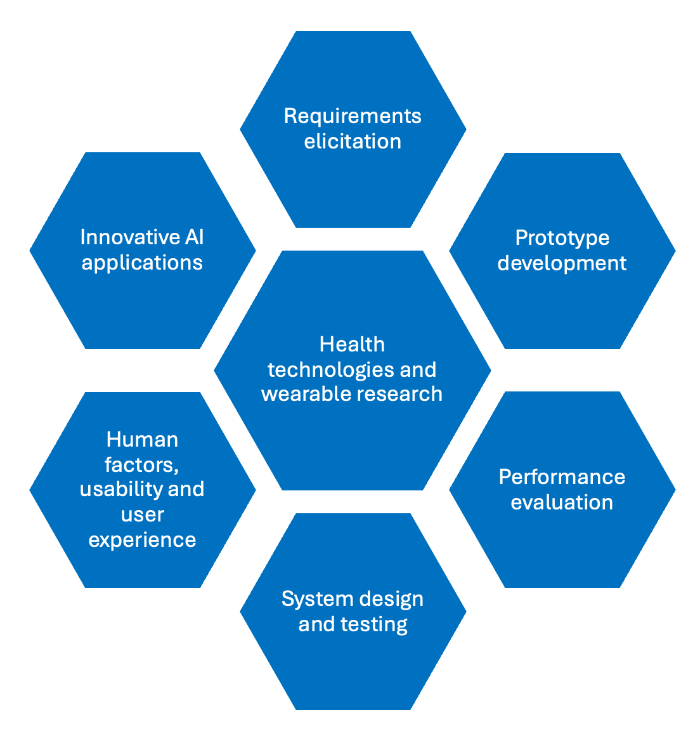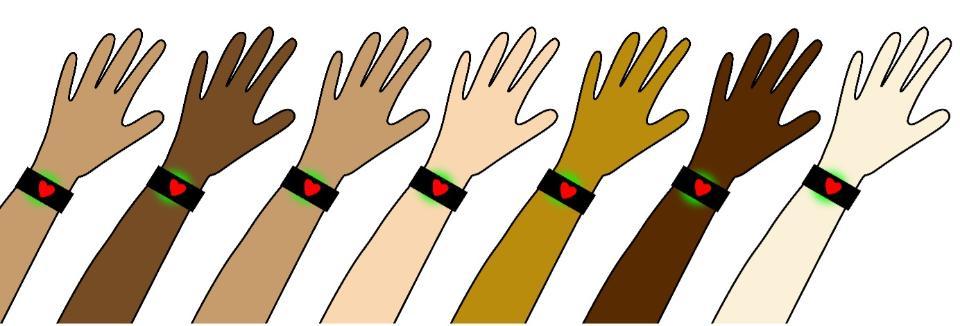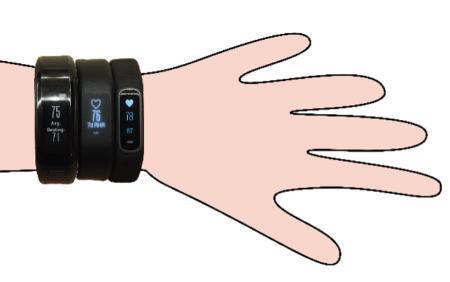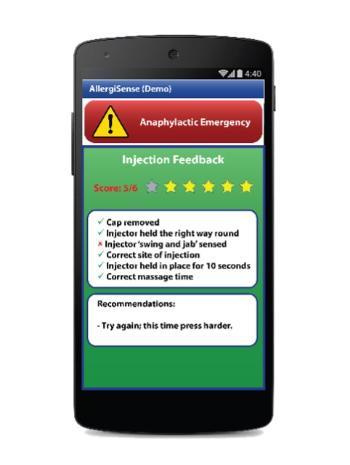Health technologies and wearables
We research, design, prototype and evaluate health technologies, sensing systems, assistive devices and wearables. We collaborate with clinicians and health professionals, and with partners and researchers locally, nationally and internationally across medicine, engineering and the health and computer science disciplines.
Research facets in health technologies and wearables

Current and recent projects
Wearables and wearable heart rate sensing
We have on-going interests in the performance and inclusivity of currently available wearable heart rate sensing systems, and in the design and prototyping of novel heart rate sensing systems.
We have evaluated the heart-rate performance of several wearable systems and we have prototyped a number of novel experimental sensing systems.
 Figure: Optical heart rate sensing works by detecting the changes in reflected light caused by passing arterial pulse waves
Figure: Optical heart rate sensing works by detecting the changes in reflected light caused by passing arterial pulse waves
Selected peer-reviewed research publications
- A Review of Wearable Multi-wavelength Photoplethysmography, Ray, D., Collins, T., Woolley, S.I. and Ponnapalli, P., IEEE Reviews in Biomedical Engineering, 16, 2023, pp. 136-151.
- Heart Rate Performance of a Medical-Grade Data Streaming Wearable Device, Rukasha, T., Woolley, S.I. and Collins, T., CHASE 2020: The Fifth IEEE/ACM Conference on Connected Health: Applications, Systems and Engineering Technologies, 2020.
- The Quantified Outpatient Challenges and Opportunities in 24hr Patient Monitoring (Best poster presentation award), EMFI Medical Informatics Europe Conference, Manchester, 2018
Other articles
- How Reliable is Your Wearable Heart Rate Monitor?
Collins, T., Pires, I., Oniani, S. and Woolley, S., The Conversation, Health + Medicine, 2018.
Inclusive wearable sensing systems
Robustly sensing human activity and physiology is not easy, particularly when individuals are active and when sensors are limited to the wrist. Activity and physiological sensors, particularly those incorporating optical sensing, have rarely performed equally for every type of individual across all sizes, ages, skin colours, fitness levels etc. But is this acceptable when popular consumer-grade wearables are transitioning from the well-being market into healthcare, health insurance and health research?

Figure: Green light optical heart rate sensors are generally more accurate for individuals with paler skin colours.
Selected peer-reviewed research publications
- Compounding Barriers to Fairness in the Digital Technology Ecosystem, Woolley, S.I., Collins, T., Andras, P., Gardner, A., Ortolani, M. and Pitt, J., IEEE International Symposium on Technology and Society (ISTAS), 2021, pp. 1-5.
Other articles
- Wearables and Connected Health Futures , Woolley, S., ITNOW, 65(1), 2023.
- Some Heart-rate Monitors Give Less Reliable Readings for People of Colour, Collins, T. and Woolley, S.I., The Conversation, Health + Medicine, 2019.
Software and systems version reporting
We have on-going research interests in the reporting of system level information in clinical trials and in the academic literature. In particular, we have interests in the reporting of software, firmware and hardware version information.
This includes a current PhD research project (Khalid Khattak) specific to the use of wearables and their reporting in clinical research and clinical trials.
Often in the academic literature and in clinical trial documentation, wearable devices are insufficiently identified. Not only are software and firmware version information insufficiently reported, but device models, families and even manufacturers can be unspecified.

Figure: Physically distinct models of the same wearable family (shown here Garmin Vivosmart family)
Selected peer-reviewed research publications
- Version Reporting and Assessment Approaches for New and Updated Activity and Heart Rate Monitors, Collins, T., Woolley, S.I., Oniani, S., Pires, I.M., Garcia, N.M., Ledger, S. and Pandyan, A., Sensors, 19(7), 1705, 2019.
- Investigation of Wearable Health Tracker Version Updates, Woolley, S.I., Collins, T., Mitchell, J. and Fredericks, D., BMJ Health & Care Informatics, 26:e100083, 2019.
- A Survey of Wearable Tracker Version Updates, Khattak, K.A. and Woolley, S.I., 36th International BCS Human-Computer Interaction Conference, pp. 49-53, 2023.
Injection sensing and training
We have long-standing interests in injection sensing and injection training. This includes interests in:
- Multimodal injection sensing
- Sensed injection training dataset curation
- Explainable AI injection training
- Visual injection training feedback
- Injection training app prototyping and development
Currently, injection competency and confidence are low amongst individuals and caregivers and also amongst the health professionals who train and support them.
Our ambition is to contribute data, insights, resources and tools to improve injection and autoinjector skills and self-efficacy amongst individuals, caregivers and health professionals.

Figure: Prototype injection training app interface [Hernandez-Munoz et al., 2017]
Selected research publications
- Evaluation of AllergiSense Smartphone Tools for Adrenaline Injection Training, Hernandez-Munoz, L., Woolley, S., Luyt, D., Stiefel, G., Kirk, K., Makwana, N., Melchior, C., Dawson, T., Wong, G., Collins, T. and Diwakar, L., IEEE Journal of Biomedical and Health Informatics, 21(1), 2017, pp. 272-282.
- Mobile Phone Tools with Ambient Intelligence for the Management of Life-Threatening Allergies, Hernandez-Munoz, L. and Woolley, S.I.
- Human Aspects in Ambient Intelligence: Contemporary Challenges and Solutions, ATLANTISAPI vol. 8, Springer, 2013, pp153-172
Evaluating wearables for epileptic seizure monitoring
We have interests in wearable epileptic seizure detecting and monitoring systems and their evaluation following a successfully completed PhD (Tendai Rukasha).
Selected peer-reviewed research publications
- Evaluation of Wearable Electronics for Epilepsy: A Systematic Review, Rukasha, T., Woolley, S.I., Kyriacou, T. and Collins, T., Electronics, 9(6), 968, 2020.
- Wearable Epilepsy Seizure Monitor User Interface Evaluation: An Evaluation of The Empatica 'Embrace' Interface, Rukasha, T., Woolley, S.I. and Collins, T., Adjunct Proceedings of the 2020 ACM International Joint Conference on Pervasive and Ubiquitous Computing and Proceedings of the 2020 ACM International Symposium on Wearable Computers, 2020.
Join us
We are very happy to receive enquiries about research and collaboration.
Please address enquiries to Sandra Woolley (s.i.woolley@keele.ac.uk) with subject ‘Health Technologies and Wearables enquiry’. You may can also find information on our Computer Science web pages about how to join us for academic visits.
Our staff and collaborators include
- Dr Sandra Woolley, Research Lead for Health Technologies and Wearables
- Dr Baidaa Al-Bander, School of Computer Science and Mathematics
- Professor Peter Ogrodnik, School of Pharmacy and Bioengineering, Keele University
- Professor John Buckley, School of Allied Health Professions, Keele University
- Sam Jones, School of Allied Health Professions, Keele University
- Dr Tim Collins, Department of Engineering, Manchester Metropolitan University
- Professor Ray Bond, School of Computing, Ulster University (Keele Visiting Professor)
- Dr James Mitchell, Anschutz Medical Campus University of Colorado, USA


